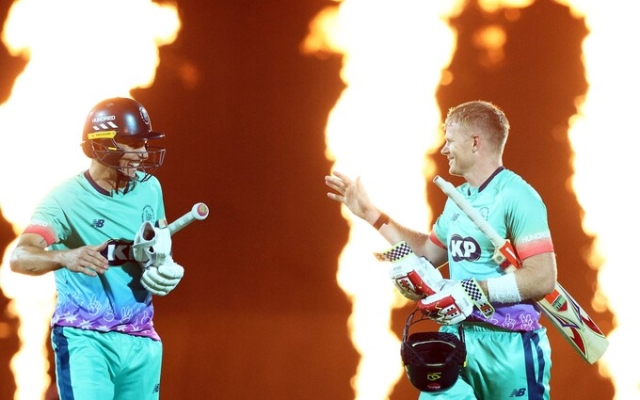 Sam Billings and Tom Curran enjoy Oval Invincibles' win over Trent Rockets Photo: Getty Images/Clive Rose
Sam Billings and Tom Curran enjoy Oval Invincibles' win over Trent Rockets Photo: Getty Images/Clive Rose
It was a classic slip of the tongue. Speaking to Sky on the opening day of this year's 100, Sanjay Patel, the tournament's managing director, said, «We're all set for the final year,» before hastily correcting himself, «Year three, sorry.»
The Freudian slip is easy enough to explain. A few months earlier, the England and Wales Cricket Board had announced that Patel was leaving.
But the comment came as the tournament started in a fog. The second season, 2022, turned out to be a failure for some reason. Many were unhappy that Ash's brilliant summer ended before early August, and that there would be no elite red ball cricket in the best month. The rain that hit at the end of July moved into August, causing seven of the first 14 games in the two competitions to be washed away. The first headline the tournament received was unwelcome when Chris Hughes of Love Island — a curious choice as the BBC's frontier interviewer — compared Southern Brave's Maitlan Brown to a Barbie.
However, the most unfortunate moment for Patel's speech was speculation about the future of the 100. As April reports said new ECB chief executive Richard Gould and chairman Richard Thompson were planning a new, «big and better» way forward for the divisive tournament and the wider English game. Five years ago, when they held the same positions in Surrey, the county's commercial cricket center, they criticized the 100. Now they are in power and publicly supported the tournament, but privately looked for ways to change its direction. This was partly facilitated by the departure of Patel, who was highly respected in the ECB.
How was this year?
Four weeks later, as the dust settles on the third issue of The 100, the mood is much more positive. By most measures it has been a very good year for the tournament.
Many things have improved in the men's tournament. Welsh Fire are no longer underdogs and close to reaching the finals, and the draft system helps to maintain a competitive balance. There were over a dozen truly even games played and the table was packed tight.
The England internationals have joined the team since the Ashes, providing a burst of stardust, and the roster of overseas talent has improved in an increasingly competitive market.
The 100's relationship with wider English male players still needs to be strengthened refinement, but this year they have improved. It was nice to have 13 players back in their respective counties to play in the one-day Metro Bank Cup when they weren't required in the 100. This serves the dual purpose of raising the ODC standard and at the same time preventing very good cricketers from wasting their August warming pines.
ODC will inevitably continue to suffer as long as it has second-tier status, but something happened to move off Broadway. Somerset sold more tickets (13,000) for one-day cricket than in any other year in this century, and Surrey accepted about 7,500 tickets for a match against Kent. Fighting Worcestershire had a few prominent spectators, while the various venues (which are increasingly lacking county championship events) were packed with spectators.
Many counties and their 40-50,000 members (19,000 of which are now in Surrey) are still disfranchised from the tournament, leaving towns like Taunton with just four days of cricket in August and there are fears that districts will receive royalties for hosting the tournament. Hundreds widen the gap between the haves and have-nots. However, district leaders appreciate the £1.3 million annual golden handshake they receive from the ECB for the existence of the Hundred.
There was little room for improvement in the women's competition of the 100, but it was interesting again, and this was helped by the introduction of the draft, which redistributed talent. The Oval Invincibles, two-time champions, did not make it to the finals, while the Welsh Fire and Northern Superchargers made it to the finals for the first time. It was spot that the women's eliminator was canceled when the men's eliminator was completed, another job for next year.
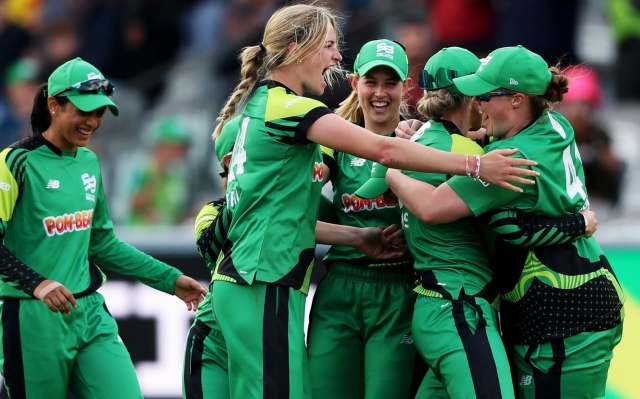 Southern Brave players celebrate their victory over the Northern Superchargers in the women's 100 final. Photo: Getty Images/Julian Finney
Southern Brave players celebrate their victory over the Northern Superchargers in the women's 100 final. Photo: Getty Images/Julian Finney
Attendance was high. The tournament sold 580,000 tickets (more than in the first two years), with about 300,000 people showing up early enough for the women's games, according to the ECB. The women's final was attended by 21,636 people, a record for women's cricket in the UK. Indeed, record attendance for women's matches of over 10,000 was a daily occurrence. The target audience is revealed: 30 percent of ticket holders were women, 23 percent were children and 41 percent were families.
Given that most cricketers have batting older than the tournament, the crowd is surprisingly large. interest and increasing commitment, as evidenced by the significant volume of goods sold, which is up 21 percent this year.
Sky, which invests around £200 million annually in English cricket, is pleased with the tournament's progress, with an eight per cent increase in spectators for men's matches and a 20 per cent increase for women's. And on social media, an increasingly important audience driver, they provided enough viral moments to break through, such as Shabnim Ismail's hat-trick when Birmingham Phoenix needed four goals to win out of three, Spencer Johnson scored three ball to one out of 20; and the illustrious centuries of Tammy Beaumont and Harry Brook.
Harry Brook scored a staggering 105 in just 42 balls… the fastest century in the 100! 🤯👏 pic.twitter.com/f4vHIqhTbB
— Sky Sports Cricket (@SkyCricket) August 22, 2023
It's inevitable that the 100 will still have critics three years from now. It's new, it's bright, and it's been treated very badly at times by the ECB, which pushed away much of its core support when it was created. But this year, there is reason to believe that he is winning over critics and getting back on his feet. It has not yet fully fitted into the English cricket landscape, but is already progressing.
What changes can happen?
In 2024, the 100 will allegedly remain the same. It will be a week earlier on the calendar and will be played at the same time as the England men's test match (not to mention the match against the Olympic Games in Paris), but in general there will be no difference.
The first problem to be solved from 2025 is the organization of free broadcasting. The BBC television cricket deal — both international (they show England some of the men's and women's T20 games live) and The 100 — will expire at the end of next summer. At this stage, although sources indicate that the BBC will apply for an extension, optimism that the deal will be agreed is nothing more than lukewarm. It is not clear if this is due to the BBC not liking what they have, concerned about how it might change, finances or some other whim of the national broadcaster.
The ECB would not like to lose BBC TV, which they have nurtured for years in the game and had a say in the development of the tournament, especially given the cross-promotion they can provide on social media, radio and other platforms, but are confident in providing yet another free broadcast if a deal cannot be agreed upon.
The main broadcast deal with Sky runs until 2028 and includes the tournament in its current form. Entering the market around 2027 with its next major rights deal starting in 2029, the ECB will be able to offer broadcasters whatever competitions and events they like.
However, the move to The 100 could happen before 2029 years as there is growing awareness that some kind of private investment is needed in English cricket.
The injection of private cash is a trend throughout the global game as boards try to diversify their income streams. Broadcasters' interest in investing millions in advocacy — especially for the bilateral men's international competition that was once the financial backbone of cricket — is waning.
Tournaments have launched this year in South Africa, the United Arab Emirates and the United States with significant private support. Major League Cricket takes place in July, thus becoming the first summer in the northern hemisphere that was once exclusively English. Tournaments in North America (MLC plus Global T20 in Canada) and the Caribbean Premier League complement the 100 and are real contenders because they pay players more. First, they will exceed the amount that the ECB can pay to foreign talent, and eventually to English players. So the Hundred needs to raise the salaries of men, but also women, as the gender pay gap is currently too large.
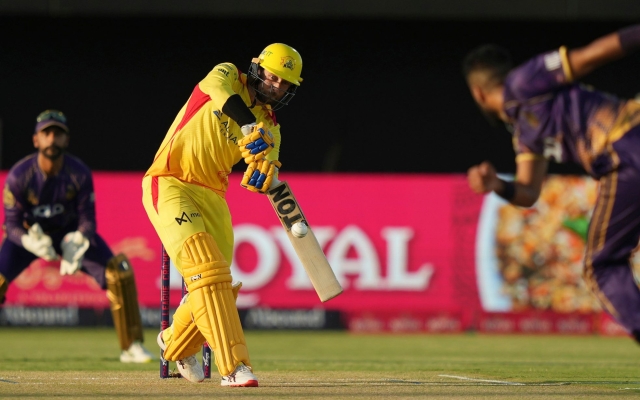 Texas Super Kings batsman David Miller takes on the Los Angeles Knight Riders' Ali Khan during a Major League Cricket match Photo: AP/LM Otero
Texas Super Kings batsman David Miller takes on the Los Angeles Knight Riders' Ali Khan during a Major League Cricket match Photo: AP/LM Otero
Ensuring any form of private investment would require the permission of the counties — and their usual two-thirds majority. Sky should also be ready to make any changes to what they have agreed to before 2028.
Opinions vary on how to attract private investment.
Last November, it emerged that private equity firm Bridgepoint offered the ECB £300 million for a 75 per cent stake in the tournament. It was rejected, with Thompson saying it would take «several billions» to «sell the summer.»
The easiest route for the ECB is to make up for the decline in the cost of the rights by following something akin to the Bridgepoint route: sell the 100 — some or all of the individual teams, or part or all of the tournament as a whole. Some Indian Premier League franchises are said to be ready to invest immediately if they can, especially in London teams. Rob Key, managing director of the England men's team, told Telegraph Sport last year that the eventual sale would fund the rest of the game, especially the talented districts. Ki said. “Any money the 100 makes, according to the constitution of the game, must be distributed through the game, to districts, to entertainment, to the women's game, everywhere. Sometimes you have to be careful what you wish for [criticizing the 100].»
Gould and Thompson are also open to investment, but their vision is different. Before and after his time at Surrey, Gould was General Manager of Somerset CCC and Bristol City. All three experiences shaped his sporting outlook, and he is a staunch supporter of the county game and the pyramid style system that has worked in football for centuries.
Their plans are just beginning: insiders say «only two know what they are fully planning,” and with key stakeholders such as Sky, formal consultation has yet to take place. There are up to five options left for discussion, starting with the status quo.
But their dream scenario is what is called an “investment pyramid”. This will transform the 100 so that all 18 districts are represented in the promotion and relegation structure, starting with the current eight in the top division and the remaining 10 in the bottom division. A third subdivision, possibly including the national (formerly petty) counties, could exist even below this. The format remains open for discussion, but a return to T20 seems likely. Relegation and promotion between divisions cannot be immediate or even annual.
Initially, the ECB and the host country will establish a joint venture for each team. Over time, but perhaps immediately, investments will be invited from within the UK and beyond. The host country will manage ticket sales, marketing, line-up and everything else, and all of this has so far been largely the responsibility of the ECB. An investment in, say, Surrey will cost more than, say, Derbyshire.
It is considered unlikely that this new tournament will replace both Hundred and T20 Blast. The explosion might still live on with what's left.
Could the change work?
The ideas of Gould and Thompson are well-intentioned. They come from a desire to unify a game that has been divided, in part because of the mistakes made by previous ECB regimes under the 100, and not limit the game's biggest show to seven cities. If they work, they will help counties get back on their feet and not depend on handouts. These plans will run counter to the rest of the cricket world, which can be both a strength and a weakness.
But they will have to overcome several challenges and there are private concerns about possible changes. «Pie in the sky» is an expression used by various sources as reported by Telegraph Sport.
There are fears that in an attempt to please more people, the compromise could leave both the county's supporters and the 100 «ultras» unsatisfied. This is partly because the plans remain unclear. Will the teams be named after counties or towns? Will the players just play for their district, or will they move in August? Will every game be broadcast with all the bells and whistles, or just the top division? And what happens if the best players don't make it to the top division? Or really the biggest venues?
The other part of the skepticism stems from the fact that a lot of time, effort, and money went into building the Hundred, which many say is now on the rise. Some skeptics point to the fact that their plans seem to be developed through a male lens and that even their newly formed and highly influential Professional Games Committee has only one woman (Rachel Bayash, whose sporting background is not connected to cricket).
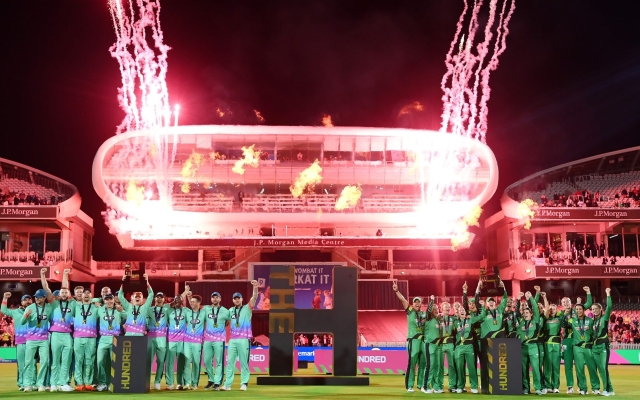 Combining male and female games was the success of The 100. Photo: Getty Images/Alex Davidson
Combining male and female games was the success of The 100. Photo: Getty Images/Alex Davidson
How does the female game fit into this? Is it possible to throw out the baby with the water (women's game) (decades of debate about the male structure)? The Women's 100 cannot continue without the consequences of the cancellation of the men's competition. Despite all the progress made, the women's game is not yet ready for 18-team competition, but it benefits enormously from being aligned with the men's game.
Any change in the format of matches will be detrimental to the women's game. With two hundred balls a day matches, the women's and men's products are created in just over six hours, which is suitable for both TV presenters and visiting families who return home around 9 p.m. Double headers — which happened by accident due to the pandemic but were a resounding success — would be nearly impossible in a T20 tournament. Women and men playing in the same colors in a row is one of the differences between the 100 and all team sports.
There are also doubts because many well-informed observers simply do not believe that the changes can work and consider them a step backwards. IPL franchises that invest in leagues around the world have little interest in promotion and relegation. And if the largest investors wanted to cooperate with the districts, they would certainly have already done so. Potential Indian investors who came to watch the tournament are said to have been baffled by reports of the changes.
One of the reasons for the 100's existence is that broadcasters need meaningful competitions with far fewer than 18 teams competing with fewer than 18 teams. every game can be shown live, making it easy to follow and means none of the big stars or stadiums will be relegated. They would be furious if Jos Battler or the Lords were relegated to the second division.
It seems likely that a two-thirds majority of counties will support the change, but it will be harder to convince broadcasters and investors. And if one or both are not interested in this, the amounts are unlikely to converge. With more rivals in English football than ever before, the sums must add up to keep pace.
Gould and Thompson will be carefully consulted in the months and years ahead, but English cricket must make a decision. . The 100, for all their malice, may be close to achieving their goals of attracting new audiences and financially protecting the English game. Is it really time to take another leap into the unknown?












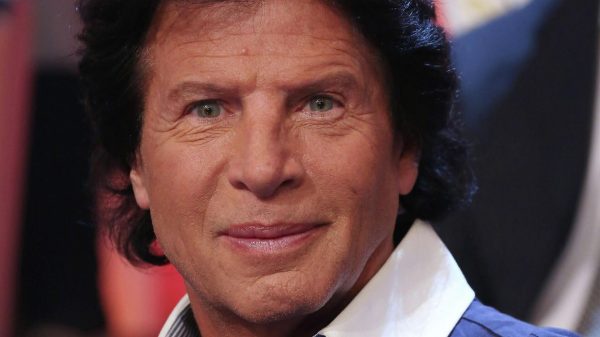
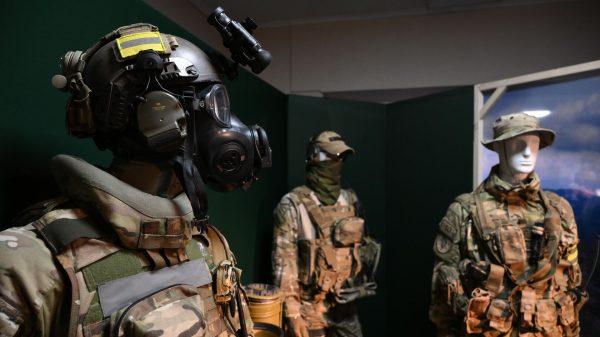

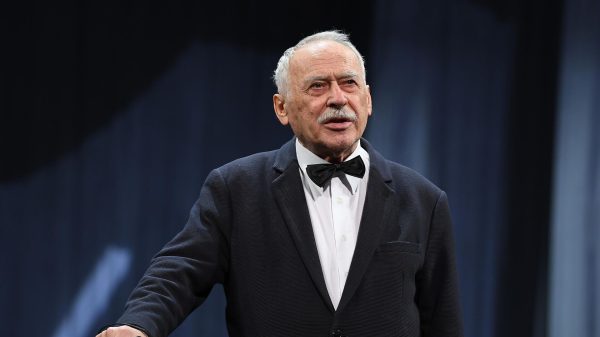



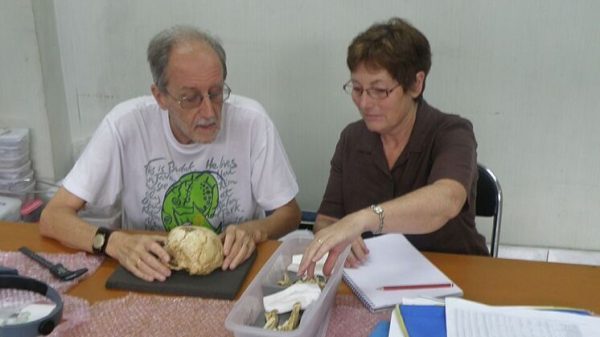































Свежие комментарии